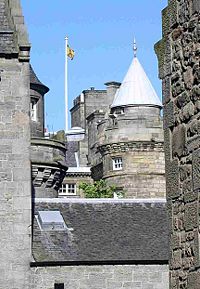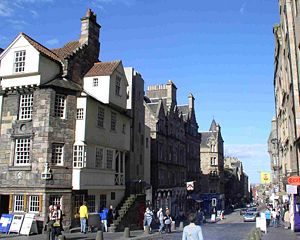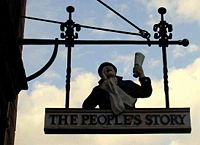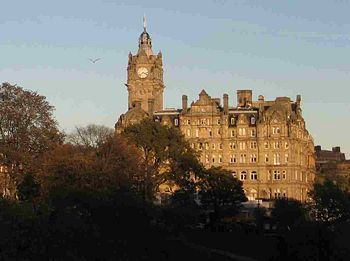Edinburgh/External Links: Difference between revisions
Jump to navigation
Jump to search
imported>Gareth Leng (moved) |
imported>Gareth Leng (→Tourist attractions: camera obscura) |
||
| Line 34: | Line 34: | ||
* [http://www.thedungeons.com/en/edinburgh-dungeon/index.html The Edinburgh Dungeon] is one of Edinburgh’s more unpleasant tourist “attractions”, displaying instruments of torture, and relating tales of horror and cruelty with gleeful prurience and a cavalier disregard for historical veracity. | * [http://www.thedungeons.com/en/edinburgh-dungeon/index.html The Edinburgh Dungeon] is one of Edinburgh’s more unpleasant tourist “attractions”, displaying instruments of torture, and relating tales of horror and cruelty with gleeful prurience and a cavalier disregard for historical veracity. | ||
* [http://www.edinburghzoo.org.uk/ Edinburgh Zoo], opened in 1913 | * [http://www.edinburghzoo.org.uk/ Edinburgh Zoo], opened in 1913 | ||
* [http://www.camera-obscura.co.uk/ Camera Obscura and World of Illusions] on Castlehill | |||
==Hotels== | ==Hotels== | ||
Revision as of 04:38, 11 January 2008
Museums and Galleries
- the Palace of Holyroodhouse, founded as a monastery in 1128, is The Queen's official residence in Scotland. Mary, Queen of Scots lived here between 1561 and 1567. Today, the Palace is the setting for State ceremonies and official entertaining, and is open to the public when the Queen is not in residence there. Adjacent to the Palace, the Queens Gallery displays exhibitions of art from the Royal Collection.
- Edinburgh CastleOne of the UK's leading tourist attractions, the Castle's features include St Margaret's Chapel - Edinburgh's oldest building, dating from the 1100s; Crown Square - the main courtyard, developed in the 15th century; The Great Hall with a hammerbeam roof built by James IV; The Half Moon Battery, from the late 16th century; and The Scottish National War Memorial added after the First World War. The Edinburgh Military Tattoo is held every Summer in the esplanade outside the Castle.
- The City of Edinburgh Museums and Galleries Includes information on The Museum of Childhood and The Writers' Museum.
- The National galleries of Scotland
- National Museum of Scotland Chambers' Street
- National War Museum at Edinburgh Castle
- National Museums Collection Centre Granton
- Surgeons' Hall Museums Royal College of Surgeons of Edinburgh, Nicolson Street
- City Art Centre Holds the City's collection of Scottish Art, and hosts temporary exhibitions.
- Georgian House at 7 Charlotte Square. Owned by the National Trust for Scotland. One of Robert Adam's designs for Charlotte Square, considered a masterpiece of urban architecture, and now restored as a typical 1790-1810 mansion. China, silver, paintings and furniture are on display.
- Gladstone’s Land, in the Lawnmarket, Royal Mile. Owned by the National Trust for Scotland, this is the 17th century tenement home of an affluent merchant.
- John Knox House
- The Leith Gallery Scottish contemporary art
- Royal Botanic Gardens founded in 1670 and moved to its present location in Inverleith in 1820.
- [1] Designed by William Playfair, this is one of the finest galleries in Britain, containing works by Tintoretto, Titian, Poussin, Claude Lorraine, Rembrandt, Reynolds, Gainsborough, Chardin, Antonio Canova and Turner, as well as French Impressionists, and Scottish artists.
- Lady Stair’s House/Writer’s Museum on the Royal Mile, displays manuscripts, relics and memorabilia of Robert Burns, Sir Walter Scott and R.L. Stevenson.
- The Fruitmarket Gallery Changing international exhibitions of contemporary art, in the former Fruit Market south of Waverley Station in the center of Edinburgh.
- The Museum of Edinburgh, formerly known as Huntly House, occupies 16th and 17th century buildings in the heart of the Old Town. Exhibits include:the feeding bowl and collar belonging to Greyfriars Bobby; the National Covenant, the petition for religious freedom signed by Scotland’s Presbyterians in 1638; and the original plans for Edinburgh’s New Town drawn by architect James Craig.
- The Museum of Childhood on the Royal Mile, displays toys, costumes, books, dolls and games.
- National Portrait Gallery Queen St.
- The People's Story is housed in the late 16th century Canongate Tolbooth opposite the Museum of Edinburgh, on The Royal Mile. ' The People's Story ' uses oral history, reminiscence, and written sources to tell the story of the lives, work and leisure of the ordinary people of Edinburgh, from the late 18th century to the present.
- Mary King Close
Tourist attractions
- Dynamic EarthVisitor attraction run by a charitable trust committed to the education and lifelong learning of Earth sciences
- The Scott Monument on Princes St. is a 200 ft. high neo-Gothic spire commemorating the poet and novelist Sir Walter Scott(1771-1832) with 64 statuettes of Scott's novels' characters. Four viewing platforms (287 steps by narrow stairs to the top) allow dramatic views of Edinburgh. Scott's novels were enormously popular in the early 19th century, and he is said by some modern scholars to have had a seminal influence on the development of the European novel genre, but his popularity with readers had declined markedly by the end of the 19th century and never recovered.
- Scotch Whisky Heritage Centre on the Royal Mile is an exhibition about the whisky making process.
- Nelson's Monument at Calton Hill is a 106 ft. tall, tiered, circular tower with viewing gallery overlooking the city. It commemorates Admiral Lord Nelson's victory and death at the battle of Trafalgar on 21 October 1805.
- The Royal Yacht Britannia is moored at Ocean Terminal, Leith.
- The Edinburgh Dungeon is one of Edinburgh’s more unpleasant tourist “attractions”, displaying instruments of torture, and relating tales of horror and cruelty with gleeful prurience and a cavalier disregard for historical veracity.
- Edinburgh Zoo, opened in 1913
- Camera Obscura and World of Illusions on Castlehill
Hotels
- The George
- The Balmoral Hotel, at the east end of Princes Street
- The Caledonian Hotel, at the west end of Princes Street



